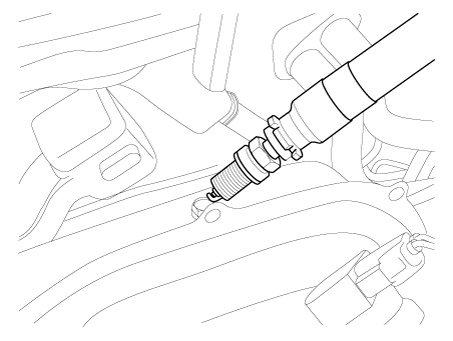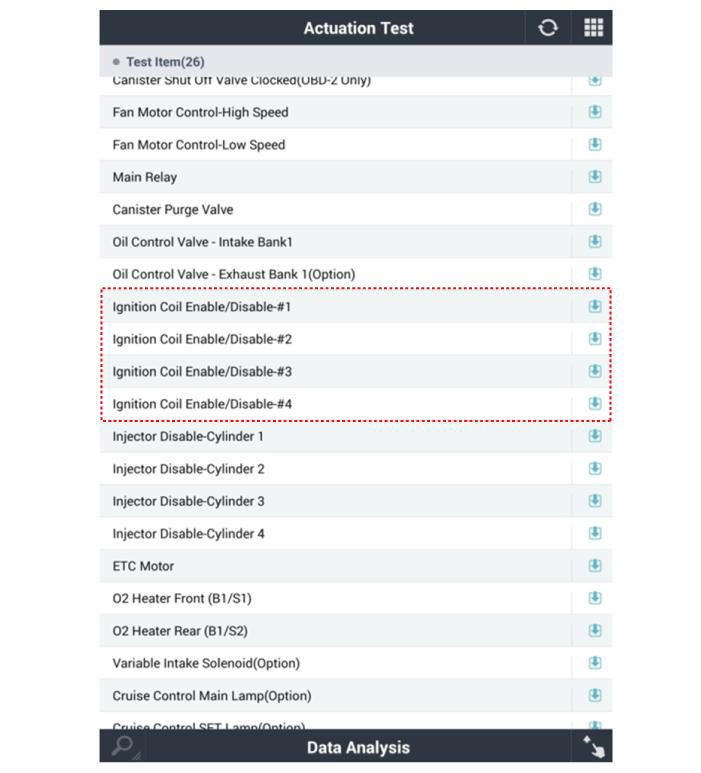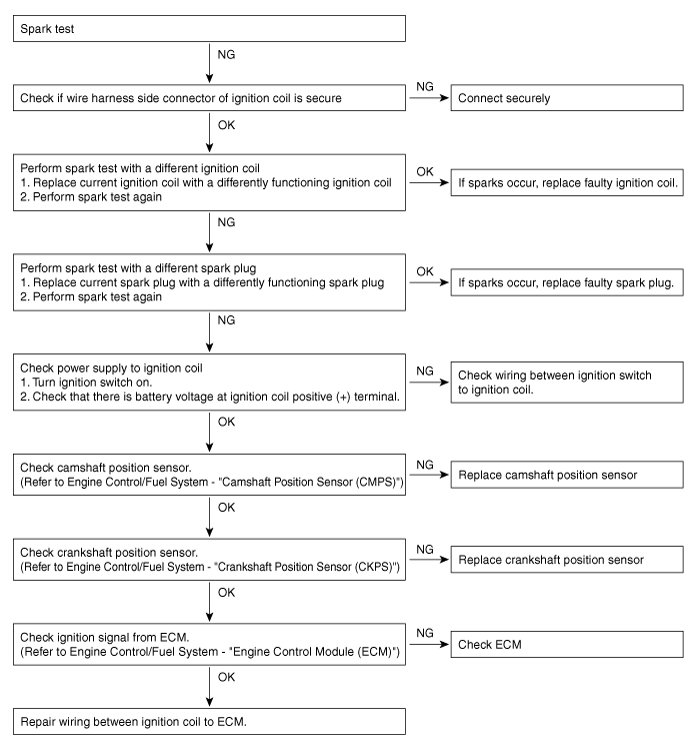Hyundai Tucson: On-vehicle- Inspection
Inspect ignition coil assembly and Perform spark test
- Check for DTCs.
WARNING
If a DTC is present, perform troubleshooting in accordance with the procedure for that DTC.
(Refer to DTC guide)
- Check if sparks occur.
Without diagnostic tool
(1) Remove the engine cover.
(Refer to Engine Mechanical System - "Engine Cover")
(2) Remove the ignition coils.
(Refer to Ignition System - "Ignition Coil")
(3) Using a spark plug wrench, remove the spark plugs.
(Refer to Ignition System - "Spark Plug")
(4) Connect the connector after install the spark plug to ignition coil.
(5) Ground the spark plug to the engine.

(6) Check if sparks occur at each spark plug while engine is being cranked.
WARNING
Do not crank the engine for more then 5 seconds
With diagnostic tool
(7) Remove the engine cover.
(Refer to Engine Mechanical System - "Engine Cover")
(8) Remove the ignition coils.
(Refer to Ignition System - "Ignition Coil")
9) Using a spark plug wrench, remove the spark plugs.
(Refer to Ignition System - "Spark Plug")
(10) Connect the diagnostic tool to data link connector (DLC).
(11) Turn the ignition switch ON.
(12) Select "Vehicle, Model year, Engine, System".
(13) Select "Actuation Test".
(14) Select "Ignition Coil Enable/Disable-#1, #2, #3, #4".


WARNING
Do not crank the engine for more then 5 seconds.
- If sparks do not occur, perform the following test.

- Using a spark plug wrench, install spark plugs.
(Refer to Ignition System - "Spark Plug")
- Install the ignition coils.
(Refer to Ignition System - "Ignition Coil")
- Install the engine cover.
(Refer to Engine Mechanical System - "Engine Cover")
Description
The ignition coil is mounted on the top side of the cylinder head cover end. The ignition coil consists of the primary coil that receives battery power and the secondary coil that generates high voltage.
When the current in the primary coil is cut off by the ignition signal of the ECM, the rapid change of the magnetic flux by the mutual induction action is induced to the secondary coil and high voltage is generated depending on the coil winding ratio.
This high voltage generated from the secondary coil is caught in the spark plug gap and discharges as the electric field is destroyed to generate a spark.
READ NEXT:
 Connector assembly status test- Troubleshooting
Connector assembly status test- Troubleshooting
Connector assembly status test
Disconnect the ignition coil connectors (A) and reinstall it.
Test for changing position of each ignition coil
Ignition coil w/ misfire code
Ignition coil w/o misfire code
WARNING
Do not move wi
 Engine Cover
Engine Cover
Removal
Turn the ignition switch OFF and disconnect the battery (-) terminal.
Remove the engine cover.
(Refer to Engine Mechanical System - "Engine Cover")
Disconnect the ignition coil connectors (A).
WARNING
When remov
 On vehicle inspection
On vehicle inspection
Inspection
Accelerate the engine to about 3,000 rpm 3 times or more.
Remove the spark plug.
(Refer to Spark Plug - "Removal")
Check the spark plug visually.
If the electrode is dry, the spark plug is normal.
If the
SEE MORE:
 Inspection with Diagnostic Tools
Inspection with Diagnostic Tools
In the eCall system, failure can be quickly diagnosed by using the vehicle
diagnostic system.
The diagnostic system provides the following information.
1) Self diagnosis : Checking failure and code number (DTC)
2) Current data : Checking the s
 DCT (Dual Clutch Transmission) System (SBC) - Removal
DCT (Dual Clutch Transmission) System (SBC) - Removal
Removal
Turn ignition switch OFF and disconnect the negative (-) battery cable.
Remove the air cleaner assembly and air duct.
(Refer to Engine Mechanical System - "Air cleaner")
Remove the ECM.
(Refer to Engine Control / Fue
Information
- Home
- Hyundai Tucson - Fourth generation (NX4) - (2020-2023) - Owner's Manual
- Hyundai Tucson - Fourth generation (NX4) - (2020-2023) - Workshop Manual